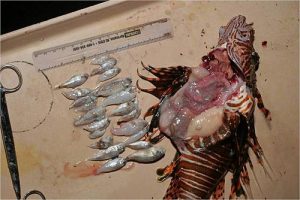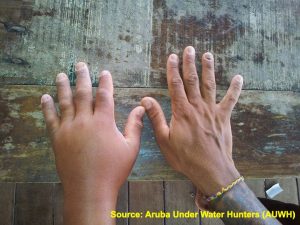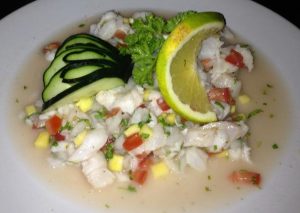The following questions are the most frequently asked about the non-native, invasive lionfish. We have additional links to a comprehensive list of lionfish facts, most common lionfish myths as well as a 7 interesting (and shocking) facts you might not know about this very serious issue facing our underwater ecosystems in the Western Atlantic Basin.
If you find these facts useful in your research about lionfish and other invasive species, please consider providing a back link to Lionfish.co, giving us a Google+1, a Facebook “like” or a mention on Twitter so that we can continue with our mission and effectively reach others like yourself in a meaningful and educated way.
Thank you!
Why are lionfish so bad? Are lionfish a problem?
We’ve written an extensive article on why lionfish are a serious problem but provide the following summary: Lionfish pose a significant danger to the entire ocean eco-systems they invade economically, environmentally, and ecologically. In their non-native habitats lionfish have no predators having any effect on their exploding population. They are highly resistant to disease and infection. Females can lay up to 2 million eggs per year that largely escape predation due to a repellant occurring in the fertilized egg mass. This means that huge percentages of lionfish fry will recruit to the safety of structure and mature with little predatory stress.
 Lionfish are voracious predators! They will eat almost any marine creature it can fit into its mouth, up to 2/3 of its own body size and include fish that are commercially important- juvenile snapper, grouper, flounder and other common “table fish;” recreationally important – juvenile billfish, mahi mahi, wahoo, jacks, tuna and other prized “game fish” for anglers as well as the creatures divers enjoy seeing like octopus, sea horses, lobsters, crabs, etc; and ecologically important – the cleaner fish and shrimp that keep bigger fish healthy by removing parasites and other disease causing organisms and the grazing creatures that keep the reef free of algae and other growth that would otherwise smother the reef to death.
Lionfish are voracious predators! They will eat almost any marine creature it can fit into its mouth, up to 2/3 of its own body size and include fish that are commercially important- juvenile snapper, grouper, flounder and other common “table fish;” recreationally important – juvenile billfish, mahi mahi, wahoo, jacks, tuna and other prized “game fish” for anglers as well as the creatures divers enjoy seeing like octopus, sea horses, lobsters, crabs, etc; and ecologically important – the cleaner fish and shrimp that keep bigger fish healthy by removing parasites and other disease causing organisms and the grazing creatures that keep the reef free of algae and other growth that would otherwise smother the reef to death.
They are gluttonous feeders, meaning that they will eat as much as they can physically manage as often as they are able; lionfish stomachs can expand up to 30 times their normal volume. Native marine creatures and fish stock do not instinctively recognize lionfish as predators and are easily hunted. Science has demonstrated that a single lionfish can reduce marine creatures by 80% to 90% in its range within 5 weeks. When food is scarce, a lionfish’s metabolism can essentially crawl to a stop; Lad Akins, Director of Special Projects at REEF, said in one presentation not long ago that studies have shown that lionfish can live without food for up to 3 months and only lose 10% of their body mass.
Here’s the bottom line:
Invasive lionfish are disastrously out-breeding, out-living, out-eating and out-competing every other native fish in the Western Atlantic Ocean, Gulf of Mexico and the Caribbean Sea. If left unchecked lionfish will ultimately cause the destruction of the reefs, native fish stocks and the livelihoods of everyone that depend upon them.
Where are lionfish originally from? Where do lionfish come from?
The lionfish invasion consists almost entirely of two species of lionfish, Pterois volitans (red lionfish) and Pterois miles (common lionfish or devil firefish). Virtually indistinguishable from each other outside of the laboratory, P. volitans is thought to make up approximately 93% of the total invasive population. Both the red lionfish and common lionfish come from the oceans of the Indian & South Pacific Oceans (Indo-Pacific) and the Red Sea as depicted in this map of their native range and habit:
How long have lionfish been considered a problem or threat? When did lionfish get here in the Western Hemisphere?
The first documented sighting of lionfish in the United States occurred in October of 1985 when a crab trap fisherman, Richard Nielsen, fishing off of Dania, Florida, brought up a red lionfish in a crab trap. While this is the first confirmed sighting, there are unconfirmed stories of very rare lionfish sightings along the east coast of the United States by fishermen and scuba divers from as early as the ’70s. It’s safe to assume that non-native lionfish were a threat to the local environment the very day they were introduced.
Click on the video below to watch the lionfish population explosion as it occurred between 1985 and 2013, pay particular attention to the progression through the years beginning with 2007.
This video is based upon visual sighting data reported to REEF, NOAA and the USGS; considering that lionfish can live to depths of at least 1000 feet or 305 meters, the actual lionfish population is probably much worse.
How did lionfish get to the Western Atlantic Ocean, into the Gulf of Mexico and spread throughout the Caribbean?
How lionfish were first introduced into the Western Hemisphere is a topic of much debate and consternation. One theory is that several lionfish somehow escaped and were swept into the sea when a private aquarium in Florida was destroyed during Hurricane Andrew in 1992. This is likely NOT the cause for the lionfish invasion because confirmed lionfish sightings date back to 1985.
Another theory is that lionfish, or more probably lionfish egg masses, were transported into the Western Atlantic Basin in ship’s ballast tanks. This theory, as it relates to lionfish, cannot necessarily be disproven and there is plenty of proof that non-native marine species have been spread through the ballast tanks of commercial ocean going vessels. Ultimately, a severe lack of genetic diversity in the invasive population tends to lead scientists in other directions looking for the source and cause.
Today, most scientists agree that the lionfish invasion was started by lionfish removed from home aquariums and disposed of into the Atlantic ocean around Southeast Florida.
Lionfish egg masses and larvae were then distributed across the Western Atlantic Basin via ocean currents. Lionfish are now found as far north as Rhode Island and as far south as Brazil. Wintertime ocean temperatures seem to be the only limiting factor of their distribution as it is believed that lionfish are unable to survive water temperatures below approximately 50 degrees Fahrenheit or 10 degrees Celsius
Do lionfish have natural predators in the Indo-Pacific Oceans and Red Sea?
Natural predators in the Indo-Pacific and Red Sea that are known to eat lionfish include sharks, cornetfish, grouper, large eels, frogfish and other scorpionfish. There is speculation that large snapper and some species of trigger fish eat lionfish in their native ranges as well.
What is being done to control lionfish? What can be done about lionfish? Can we train other native fish to eat lionfish?
It doesn’t appear likely that we can train native fish to hunt and eat healthy lionfish. It has been tried with sharks and groupers. There are several problems associated with this approach; first, in one experiment in which researchers placed a small lionfish in a tank of several hungry grouper, the much larger predators actually cowered away from the aggressive lionfish and avoided it almost to the point of starving to death before the researchers intervened. Secondly, fish do not train their offspring to hunt like a mammal does. There is really know “transfer of knowledge” and every new generation of predator would have to be trained. Thirdly, ad hoc training by inexperienced handlers only produces a perilous situation in which the “trainers” (mostly well-meaning divemasters and instructors) teach large and potentially dangerous predators to equate lionfish hunters with food. In turn, these animals have become quite aggressive in locations across the affected area and have caused serious injuries to other divers and numerous close-calls. I don’t know about you, but I don’t want to be chased by sharks, eels and barracuda every time I go lionfish hunting. Lastly, stories of grouper eating healthy lionfish are becoming more frequent but a study very recently published indicated that the *number* of predators, i.e. grouper, are so low that they are having very little, if any, effect on the invasive lionfish population.
Absent any naturally occurring predator or environmental solution to control the exploding lionfish population and slow the lionfish invasion, it would seem that humans must actively target and kill lionfish through hunting, fishing and trapping.
Hunting with a speargun, pole spear, Hawaiian sling or other pointy object is the most effective. Lionfish are rarely caught on a hook & line or fishing pole but it does happen on accident. Experiments are underway to use special fish traps and larval traps, but the concern of unintended by-catch is always a concern.
Visit our lionfish hunting page for more information about tools, techniques and other considerations while lionfish hunting.
Are lionfish dangerous to humans? Do lionfish attack people?
Lionfish are not aggressive towards humans and we’ve never documented a story in which a lionfish has offensively attacked anyone. Lionfish have most certainly caused injuries to people out of self defense or by accident. Most often divers are stung by lionfish while hunting and a thrashing lionfish either gets off of the spear tip and blindly swims into the hunter while it’s trying to escape. Divers are also prone to being envenomated while trying to put a lionfish into a bag or storage device. Likewise, divers also get hurt when they are too close to a lionfish hunter at work and especially the lionfish at the end of his or her spear.
Divers and underwater photographers have been hurt because they either didn’t see a lionfish or got entirely too close to what they THOUGHT was a docile fish; with a lighting fast shake the lionfish has managed to get a spine or two into the diver and the pain sets in very quickly. If you mind your buoyancy, are aware of your surroundings and NEVER touch or molest marine creatures you will entirely avoid a very painful lesson.
While rare, unsuspecting swimmers and bathers in shallow water have been known to accidentally kick or step on a lionfish causing themselves injury.
People also tend to get stung by a lionfish when handling them after a hunt or while cleaning lionfish prior to eating them. It’s easy to get careless when handling what you think is a dead fish that surprises you with a final violent “death shake,” too. Our advice is to treat a lionfish like a gun: its ALWAYS loaded until the spines are removed and disposed of safely.
Are lionfish poisonous or venomous?
Lionfish are venomous, not poisonous. Venom must be injected into the body through bites, spines, fangs and stingers while poison must be inhaled or ingested (eaten, swallowed or absorbed) in order for the toxin to have any effect. Lionfish have needle-sharp spines that are capable of delivering a potent protein-based neuromuscular toxin.
Where are the venomous spines? How many dangerous spines does a lionfish have?
Invasive lionfish (P. volitans & P. miles) usually have 18 venomous spines in all – 13 long spines in the dorsal fin, 1 short spine in each of its pelvic fins and 3 short spines in the leading edge of the anal fin.
The pectoral fins, the fins that lionfish most often fan out to their sides, and the caudal fin (the tail) do not contain any venomous spines.
What will happen to me if I get stung by a lionfish?
Symptoms of being envenomated by a lionfish include the almost immediate onset of INTENSE pain followed by swelling, redness and bruising in the area of the of the puncture wound. Secondary symptoms associated with a lionfish sting can include shortness of breath, allergic reactions ranging from minor symptoms through very serious anaphylaxis, dizziness, nauseousness, fainting and, in isolated cases, temporary paralysis. Severe pain may last for several hours and slowly decrease over the course of 24 hours and may take days to completely subside.
It should be noted the severity and duration of symptoms can be directly correlated to the amount of venom delivered, how deep the spine(s) punctured the body and the “freshness” of the venom as well as the victims own constitution or sensitivity to the venom; the protein chains in the venom begin to breakdown after the lionfish dies and is exposed to air, heat or freezing temperatures.
Can I die from being stung by a lionfish?
For a reasonably healthy adult the chances of dying are very, very low… but you might be in so much pain that you want to. There have been no known fatalities caused by a lionfish sting, though the possibility does exist as a result of the effects of shock from the intensity of the pain or complications caused by an infection if left untreated.
How do I treat a lionfish sting? What is the proper first aid for lionfish stings?
Obviously, if you are scuba diving or freediving you must safely end your dive as soon as possible and get to a safe and stable place where you can call for emergency medical services if required.
First aid and treatment of a lionfish sting includes inspecting the puncture wound and removing any pieces of the spines that may have broken off and remain in the injection site. Control bleeding and immediately apply the hottest water you can stand without scalding or burning your skin. Immersing the affected area is best but if it is not possible due to circumstances or the wound’s location, applying a clean cloth soaked in hot water is most effective. Using hot packs or a hair dryer may provide some much needed relief as well. Do not cause further damage by burning yourself.
 Despite the amount of swelling, DO NOT APPLY ICE or cold compresses until the pain has completely subsided – this will only make the pain worse and prolong the amount of time you will suffer! Common home remedies like urine, vinegar, baking soda, etc. are rarely effective against protein-based neurotoxins; they are not recommended and should be avoided.
Despite the amount of swelling, DO NOT APPLY ICE or cold compresses until the pain has completely subsided – this will only make the pain worse and prolong the amount of time you will suffer! Common home remedies like urine, vinegar, baking soda, etc. are rarely effective against protein-based neurotoxins; they are not recommended and should be avoided.
If desired, taking over-the-counter pain medications such as aspirin or tylenol can help manage the pain if you can tolerate them.
Clean the wound thoroughly as recommended for any injury caused by a marine animal or organism in order to prevent infection.
Seek medical attention immediately if you suspect anaphylactic shock (extreme allergic reaction), shortness of breath or trouble breathing, decompression illness, fainting or if the pain becomes unbearable. Additionally, if the wound appears infected or the skin surrounding the injection site appears to be blackening, putrefying or being eaten away (necrosis or tissue death).
Quite frankly, seeking medical attention is NEVER a bad idea in the event of a lionfish sting and we highly recommend it.
Can you eat lionfish? How is lionfish cooked or prepared?
Absolutely! Lionfish is delicious and can be prepared in so many ways! Ceviche, sushi, sashimi (raw), fried, baked, in soup… Lionfish is a very mild white meat with no “red line” that can be prepared just about any way snapper, mahi mahi (dolphin fish or dorado) and grouper can be prepared.
For more information see our article describing what lionfish tastes like, our lionfish cleaning and preparation page as well as our lionfish recipes page.
Is eating lionfish dangerous? Are lionfish poisonous like puffer or fugu dishes?
 The common myth that eating lionfish is somehow deadly is very wrong. Lionfish are not poisonous to eat and there is absolutely no risk of keeling over and dying from a lionfish not being prepared or cooked correctly! Even ingesting lionfish venom would not present any health risks because the venom would be denatured almost immediately when it came in contact with stomach acid (though we personally would be concerned about having fresh venom come into contact with any open sores or cuts inside of the mouth or gums… yikes!).
The common myth that eating lionfish is somehow deadly is very wrong. Lionfish are not poisonous to eat and there is absolutely no risk of keeling over and dying from a lionfish not being prepared or cooked correctly! Even ingesting lionfish venom would not present any health risks because the venom would be denatured almost immediately when it came in contact with stomach acid (though we personally would be concerned about having fresh venom come into contact with any open sores or cuts inside of the mouth or gums… yikes!).
Lionfish are extremely safe to eat in most areas, however, just like eating snapper, grouper, barracuda and over 400 other species of fish identified as potential carriers caution must be exercised in those limited areas where ciguatera fish poisoning (CFP) is a problem. Local fishermen, divers and restaurants will often be aware if ciguatoxins cause local seafood concerns.
Do you have a question about lionfish that you would like answered? Send it to us via email by clicking here!




Let us know if you have additional questions in a comment below!
how come lionfish dont die when you take them out of water? how do they breath outside of water if they are fish?
Lionfish will die if you take them out of water. They have gills and cannot breath outside of water.
Let’s just take all the lionfish out of the water and then they’ll die! That’s how we can stop this whole entire invasion!!!
I know this is an old article but hoping it is still monitored. What eats lionfish eggs in the Pacific? Prolific egg production is a sure sign of egg predation. I realize the inherent problems with introduction of a non-native species but would it not be a possibility in this case if an egg predator for lionfish was identified in the Pacific?
Hi Jim, my understanding is that scientists do believe there is egg predation in the Pacific probably by birds and others, but it has never been fully studied.
Yeah. I am doing a project and I need to know what Pterois Volitans eat. Thanks!
here is the real awnser. Natural predators in the Indo-Pacific and Red Sea that are known to eat lionfish include sharks, cornetfish, grouper, large eels, frogfish and other scorpionfish. i am ten
Can you list ALL of the fish lionfish eat?❤️?
can i use this article as a reference for my synthesis paper, i really need it, coz it provides so much information on my topic? i dont know who is the author is and the date of publish. i would really appreciate it 🙂
Yes you can use it just give credit to the website. It was written by Scott Harrell about 5 years ago.
thank you so much :)) youre a lifesaver
do you know if they have a backbone?
Yes, all fish are vertebrates meaning they have a spine (or backbone).
Great Article… Appreciated all the Good information.. Thanks.. From Bermuda Island. April 2022
I am part of a pioneering group out of Belize where the populations of LF have exploded in the last 5 years. I am developing trainings to assist in the education of this invasive species. Visual aids are always a plus. I am trying to find information on how many lionfish fry survive … I know they can reproduce every 4 days and up to 30,000 eggs but I want to create a visual of the approximate percentage of fry that survive from a spawning. I have not found anything on that. Ideas?
Hi Shaz,
You might try contacting Dr. James A Morris at NOAA. His profile and contact information can be found at http://www.gulfbase.org/person/view.php?uid=jmorrisjr
-Scott
I’m thinking it would have to some type of way of putting some type of chemical warfare in the water but you would have to remove the fish in the water that make up the enviromental make up because if you can’t get get them on the hook , and natural predatory fish such as sharks , groupers, etc wont attack them then you got a serious problem keep me updated Im a political major in state and local public policy with a minor in global structure .
Good job where do I get certified? I’ll hunt Florida as much as I can. Retired so I am on a limited income. Trips to carib are expensive. Great diving with you Scott. Maybe next year again.
Likewise, Dave!
I certainly hope to see you next year if you and I are both able! Lionfish harvesting regulations can be found on the FWC website – http://myfwc.com/wildlifehabitats/nonnatives/marine-species/lionfish/harvesting/
Say hello to Pat for me and go get ’em!
-Scott
Hi, I’m doing a project on Lionfish and I’m wondering how you tell the difference between a male lionfish and a female lionfish?
hey humans, stop trying to play god.
One question I’ve always had was what depth do lionfish usually hang out in? I know their depth range is from 1ft to 1000ft, but out of all the countless lionfish hunting videos I’ve seen, most of them took place at around 100ft of water and were bucketing lots of them(which is kind of unfortunate for me being that I’m just now working on my open water course). So I wanted to know for sure if that’s the real “sweet spot” for finding lionfish. Thoughts?
I want to try electro-fishing on these illegal aliens of the deep!!!!!
Electro-fishing works great in fresh water but not so well in salt water. As current takes the path of the least amount of resistance, saltwater is very conductive and is a better conductor than the fish, allowing the current to bypass the fish.
We love hunting…and eating lion fish!
What is the wholesale cost per pound for lionfish ?
In regards to hunting lion fish, once you have speared it and wish to leave it for other fish is it necessary to cut the spines off the lion fish for other fish to consume it or have other fish seemed to have figured out a way around the spines when eating them?
I know this is an older article, but some friends of mine have been spearing lionfish since they are taking over everything! They speared over 100 on just two 8’x8′ structures. I am wondering about targeting the eggs rather than just the adults, how can they be identified and ensure they are not confused with any other fish’s eggs?
I have lionfish from past one year in my aquarium and were doing good by eating black mollies but recently started feeling them freezed shrimp and they used to like it but from reasons unknown they stopped eating from past five days so can u help me out in this matter meant what steps should i take to caax them to eat in order for there survival
Hi Chvishnu, We can’t help you with that other than to say lionfish prefer live food. We are all about hunting and eating the invasive lionfish in the Atlantic, not keeping them in aquariums.
hey, I’m doing a project on writing a newspaper, and one of my articles is on lion fish being edible, so can someone give me some tips and facts to put in my article?
hey, about your question about the eggs, i think its a great idea to do that, but I’m going to have to do some research on the eggs appearance. sorry i can’t help more.
Is importing or introducing lionfish predators an option?
Introducing other predators is always fraught with the potential of unintended consequences. Mongoose were introduced to Hawaiian and Caribbean Islands to control the rat populations on sugar cane plantations, and today the mongoose itself threatens many native species in those places.
I was wondering if scientists have tried species of native moray eels to eat these fish. I do know that these eels are very aggressive and can get quite large. Also, species of the moray eel is found in the Caribbean. Would this be a logical solution.
Yes, the Caribbean Morey eels love to eat wounded lionfish. The problem is that we can’t really ‘teach’ predators to eat lionfish, we just end up teaching them that people will spear lionfish for them, and to chase the divers around the reef.
Please if you have a moment, point me to the reference for 80-90% reduction of marine life in five weeks. Thank you!
Hi Anna, Here is a link https://nas.er.usgs.gov/queries/factsheet.aspx?speciesid=963 where it references a 2008 study by Albin and Hixon. “Research by Albins and Hixon (2008) on small patch reefs in the Bahamas provided the first evidence of negative effects of lionfish on native Atlantic coral-reef fishes. The recruitment of coral-reef fishes was studied during the 2007 recruitment period (July-August) on small patch reefs in the Bahamas with and without lionfish. Over the five week period, net recruitment (i.e., accumulation of new juvenile fishes via settlement of larvae) was reduced by 79% on reefs with a single lionfish compared to reefs with no lionfish.”
Once the spines have been removed, how do you recommend disposing of them?
Hi Shea, the spines can be thrown away. Just sitting at room temperature will neutralize the venom in 30-60 minutes. As long as you don’t poke yourself with them in the short term they can just be tossed away, but realize they are still very sharp and can cut.
How come lionfish are a bigger problem in the Atlantic and not the Pacific? Why are they not a huge problem in the Pacific?
Detailed explanation here: https://lionfish.co/why-are-lionfish-a-problem/
how have lion fish impacted the local ecosystems
Can you eat lion fish raw or is there a concern about parstitei?
Raw lionfish is healthy and delicious. Ceviche is one of the most popular ways to eat lionfish.
Pleas list all of the ? ?? eat.
I teach the padi lionfish course and I get asked 2 questions alot, “Do lionfish need deep waters to reproduce” and “how long after the lionfish are caught can the venom still affect you” I serched online for answers and can’t get any… can you help?
Thanks
No, lionfish don’t need deep water to reproduce. They can live and reproduce in any depth. As for the venom, I’ve found that at room temperature for 20 or 30 minutes if I get poked while filleting them it’s not a problem, no noticeable sting. However, if you keep them on ice they can still sting you hours or even days later.
How fast do they swim?
They’re not very strong swimmers. They can strike quickly to eat prey, but they aren’t built for speed so don’t travel much distance. Studies have found tagged lionfish usually within a few hundred meters of where they are tagged even months later.
How long do lionfish live? I had one in an aquarium for a number of years before he died. I fed it feeder goldfish and frozen shrimp. Maybe a parasite from the goldfish killed it. Just a thought!
I think they can live around 7-8 years, maybe a little more. It’s probably hard to get the diet exactly right, they love shrimp in the wild but goldfish might be a different food quality than the saltwater fish they normally eat. They make great aquarium pets, just don’t release them into the wild!
@Andy Lowe
What is “lionfish threat”? It’s part of a puzzle game I’m playing and I’m wondering whether you have any ideas about what it might mean.
Also, out of curiosity, where does your interest in lionfish spur from?
Maybe ‘Invasive’ or ‘invasion’ because of their nature of being an invasive species. My interest in lionfish spurs from them being really fun to hunt while scuba diving. I’ve always enjoyed spearfishing, but with lionfish I have learned to get more pleasure out of harvesting a 2 pound invasive species for dinner than a 30 pound grouper because I’m helping the environment rather than only taking from it.
“Invasive” and “invasion” were incorrect but they were really good guesses, thank you. And your lionfish hunting is very noble, I’m impressed. Keep on the good work Dr. Lowe.
Hi! I need to cite a scientific journal source where it talks about the predators of the lionfish in its native Indo-Pacific habitat (ex: sharks eels, grouper, cornetfish, frogfish, scorpionfish. Would you know of any? Thank you!
Sorry, I have not seen any.
Where do Lionfish come from?
From the Indo-Pacific region.
hi guys how can you help me with lionfish life cyicle